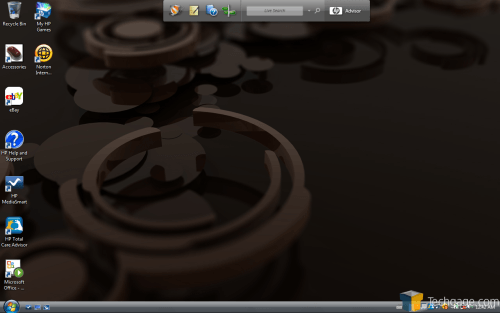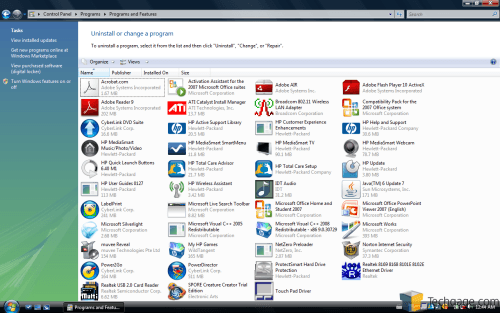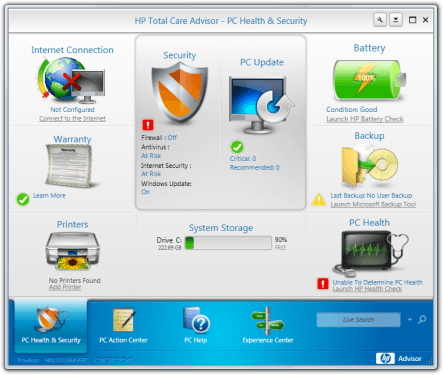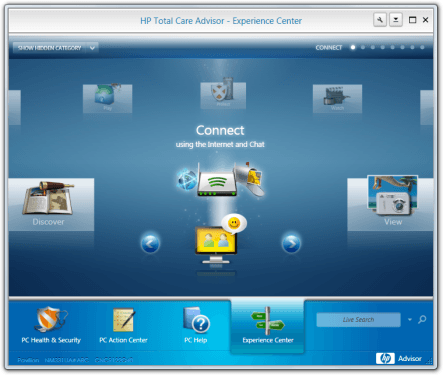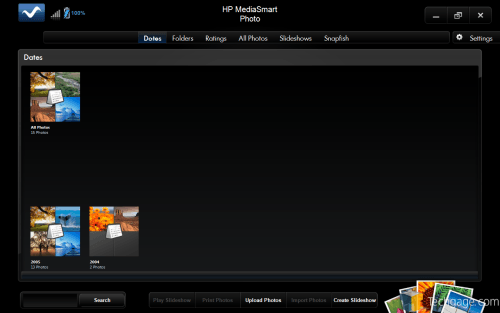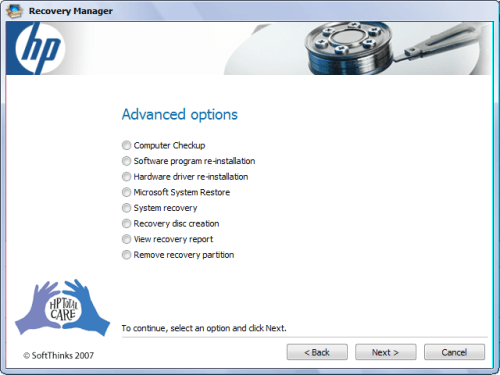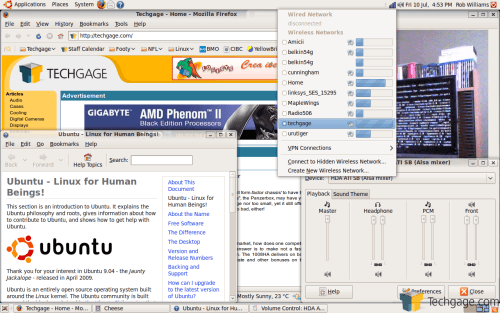- Qualcomm Launches Snapdragon 4 Gen 2 Mobile Platform
- AMD Launches Ryzen PRO 7000 Series Mobile & Desktop Platform
- Intel Launches Sleek Single-Slot Arc Pro A60 Workstation Graphics Card
- NVIDIA Announces Latest Ada Lovelace Additions: GeForce RTX 4060 Ti & RTX 4060
- Maxon Redshift With AMD Radeon GPU Rendering Support Now Available
HP dv2 12.1″ Ultra-Portable Notebook
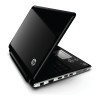
Finding a decently-sized notebook for an equally decent price can be tough, and it’s for that reason that HP’s dv2 is so intriguing. As a 12.1″ offering, you’d expect it to cost more than $600, but not so. Equipped with AMD’s Athlon Neo 64 and other competent features, the dv2 is well-worth a look if you need a new notebook on the cheap.
Page 2 – Tech Specs, Included Software
Before taking a look at the specs of the dv2, I have to admit that it’s rather pointless to talk at great depth about them. The reason? There are dozens of configurations for the dv2, and I have just one of them (dv2-1024ca). Some have different model numbers because they’re localized, but the sheer number of options available make this particular model I have unlike what you’re likely to purchase yourself.
Some of it depends on how you choose to purchase the notebook. Should you hop onto HP’s website, then you have a wide-range of options available. If you go to a brick and mortar store, you have two options. The top option comes complete with ATI’s HD 3410 graphics card (up from the X1270), a 6-cell battery (up from 3-cell), an HDMI port, Vista Home Premium (up from Basic), a boost to the memory (4GB vs. 2GB) and also an external ODD.
The model I have lacks those perks, and it’s too bad. The pricing difference overall is around $150, so if you decide that the dv2 is right for you, I highly recommend shelling out the extra. It will become a little more expensive, but the extras are well worth it, especially the Vista upgrade, 6-cell battery and also the external optical disc drive. The improved graphics card will allow you to do a bit more on that front as well.
|
Component
|
Model
|
| Model |
HP dv2-1024ca
|
| Processor |
AMD Athlon Neo 64 MV-40 1.6GHz
|
| Chipset |
AMD "Hammer" M690T
|
| Graphics |
ATI Radeon X1270 (128MB)
|
| Display |
12.1" LED WXGA (1280×800)
|
| Memory |
Micron 2GB DDR2-800 6-6-6-18
|
| Hard Drive |
Seagate Momentus 5400.5 ST9250320AS
250 GB, 5400 RPM, 8MB Cache, S-ATA 3.0GB/s |
| ODD |
None
|
| Audio |
ATI SB600
|
| Network |
Broadcom 802.11 b/g
Realtek RTL8102/8103 LAN |
| Et cetera |
Weight: 3.81 lbs (1.73 kg)
Dimensions: 11.50" (L) x 9.45" (W) x 0.93" (min) 1.29" (max) Battery: 3-Cell Lithium Ion (~3 hours) Webcam 3x USB, 1x Memory Card (SD/MMC) VGA Output, LAN 1 Year Limited Hardware Warranty |
| OS |
Windows XP Home Basic 32-bit
|
The sheer amount of choice available on HP’s website makes it easy for me to recommend checking things out there before strolling into a Best Buy or somewhere similar. That way, you’ll be able to customize to your liking and probably get a better notebook out of the deal.
Let’s check out the software then, shall we? On the first boot, you’ll be offered a robust HP interface asking you various questions, such as whether or not you want to register and other mundane things. I actually found this to be rather frustrating, because it cannot be immediately canceled, or alt-tabbed, and because it’s a full-screen application, you simply have to keep clicking “No” in order to get to your desktop.
At first glance though, the desktop looks quite nice, with a cool wallpaper and HP Advisor interface at the top. That piece of software in particular is more for the novice user, as it’s simply an interface for gathering computer information, and also trouble-shooting. Anyone who’s been using a computer for any length of time will likely want to either remove this from the start-up or un-install it entirely.
I’m not sure who was in charge of bundling software with this notebook, but they must’ve had a good laugh when they were done, because the amount of bloatware here is truly asinine. No word of a lie… it actually took me a full hour just to get rid of what I didn’t want/need (which was almost everything, except for HP’s system updater). Almost half of that time was dedicated to Microsoft Office and Norton Internet Security, though, since they both take a while to un-install.
Some of the software here is understandable, because it’s software that most people would install anyway (Adobe Flash, Adobe Reader, Microsoft Silverlight). But there’s some commercial trial-ware here as well, including Microsoft Office Home and Student 2007, SPORE, Norton Internet Security and a few others. Overall, there’s going to be a lot that you end up un-installing. I won’t even bother asking why there’s actually an installed application for Acrobat.com…
Below you can see a shot of the HP Total Care Advisor, a tool that gives you quick information about the status of your notebook, from the battery-life to your Internet connection to your installed printer and more. You can also review warranty information here and also have quick access to Windows Restore (labeled as “Backup”).
For new computer users, they can navigate to the “Experience Center” at the bottom, which will launch specific information to help them find their way around the machine, and also get online and take care of various other tasks. I only bring it up because it’s a nice interface and is easy-to-follow, although it really could use some small videos to help make the process of learning the PC a wee bit easier.
One main HP application installed is called MediaSmart, and for all intents and purposes, it’s a media viewer front-end. It runs full-screen, and allows you to do everything from browse photos to view videos. It’s definitely one of the better media-viewers I’ve used recently, although some areas of it load a bit slowly due to the performance of the notebook (primarily the video section).
To access MediaSmart quickly, you can use the keyboard shortcut which will launch this four-option bar. Simply choosing whichever is relevant at the moment will bring you directly to that section in the application.

If anything makes up for the sheer amount of bloat pre-bundled on the machine, it could be HP’s recovery software. It’s by far the best I’ve used, because it’s comprehensive. If you’re like me, you probably un-install anything you don’t explicitly need when first using a new notebook. I did that, and then realized later that a piece of software was bundled that I could use, and luckily, Recovery Manager allowed me to get it back fast.
Here, you can choose “Software program re-installation”, and it will provide a list of all pre-bundled software, allowing you to install or re-install it very quickly. All of this is stored on the recovery partition, which should never be formatted or deleted because it also contains the factory image. With the external ODD, you could also burn the factory image to disc, should you want to remove that partition.
Should you decide to restore the factory image, however, you shouldn’t plan to use the notebook again too soon after you begin the process. I ran the total recovery twice in the time I had the notebook, and each time it took over three hours to complete. Most notebooks I’ve used recently have only taken one hour tops, so to see this one take three hours… it was a little jaw-dropping. For comparison, the ASUS Eee PC 1008HA we reviewed a few weeks ago restored itself in about fifteen minutes.
Overall, I think my stance on the bloatware remains clear, so I certainly don’t think the dv2 excels where software is concerned. If that software is the reason the notebook is affordable, then great, but I sure do wish it was a lot quicker to un-install.
Linux Support
When time allows, I’d like to start adding a small feature to each notebook review stating Linux support, since I do use the OS quite heavily, especially on notebooks. Being that the CPU found here is brand-new, I didn’t expect the best support out there, but I was rather surprised. However, for some reason the latest version of Ubuntu (9.04) would not boot, so rather than taking the time to trouble-shoot, I tried 8.04 instead, and I had much better luck there.
From the get-go, everything worked, with absolutely no tweaking required. The graphics functioned fine, but since this card isn’t explicitly supported by the latest binary driver from ATI, the 3D aspects didn’t function as well as they did in Windows. Aside from that, the desktop graphics worked fine, with no lag. Also supported was the WiFi, audio and of course the USB ports and memory card reader. To put it simply… everything worked (even the webcam, as you can see in the picture below).
One issue I did run into though was when I upgraded to 9.04 through the OS’ built-in updater. The update process went fine, but afterwards, the audio failed to work. Everything else did, but even though the proper kernel module was loaded (ironically, “snd_hda_intel”), nothing would come out of the speaker. I still haven’t figured out this issue, but I have no doubt it can be remedied. I tried Fedora as well, but the latest version wouldn’t boot for whatever reason, so I’d recommend taking the Ubuntu route if you do want to install Linux on the dv2.
Support our efforts! With ad revenue at an all-time low for written websites, we're relying more than ever on reader support to help us continue putting so much effort into this type of content. You can support us by becoming a Patron, or by using our Amazon shopping affiliate links listed through our articles. Thanks for your support!




